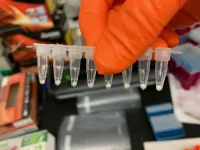(Press-News.org) Hurricanes that make landfall typically decay but sometimes transition into extratropical cyclones and re-intensify, causing widespread damage to inland communities
The presence of a cold core is currently used to identify this transition, but a new study has now found that a cold core naturally forms in all landfalling hurricanes
The cold core was detected when scientists ran simulations of landfalling hurricanes that accounted for moisture stored within the cyclone
Over time, the scientists saw a cold core growing from the bottom of the hurricane, replacing the warm core
The research could help forecasters make more accurate predictions on whether communities farther inland will be impacted by these extreme weather events
Hurricanes are powerful weather events born in the open sea. Fueled by moisture from the warm ocean, hurricanes can intensify in strength, move vast distances across the water, and ultimately unleash their destruction upon land. But what happens to hurricanes after they've made landfall remains an open question.
Now, a recent study in Physical Review Fluids has used simulations to explore the fate of landfalling hurricanes. The scientists found that after landfall, the warm, dynamic heart of a hurricane is replaced by a growing cold core - an unexpected finding that could help forecasters predict the level of extreme weather that communities farther inland may face.
"Generally, if a hurricane hits land, it weakens and dies," said Professor Pinaki Chakraborty, senior author and head of the Fluid Mechanics Unit at the Okinawa Institute of Science and Technology Graduate University (OIST). "But sometimes, a hurricane can intensify again deep inland, creating a lot of destruction, like flooding, in communities far away from the coast. So, predicting the course that a hurricane will take is crucial."
These re-intensification events occur when hurricanes, also known as tropical cyclones or typhoons in other global regions, transition into extratropical cyclones: storms that occur outside the Earth's tropics. Unlike tropical cyclones that harness their strength from ocean moisture, extratropical cyclones gain their energy due to unstable conditions in the surrounding atmosphere. This instability comes in the form of weather fronts - boundaries that separate warmer, lighter air from colder, denser air.
"Weather fronts are always unstable, but the release of energy is typically very slow. When a hurricane comes, it can disturb the front and trigger a faster release of energy that allows the storm to intensify again," said first author Dr. Lin Li, a former PhD student in Prof. Chakraborty's unit.
However, predicting if this transition will occur is challenging for weather forecasters as hurricanes must interact with this front in a specific and complex way. Currently, forecasters use one key characteristic to objectively identify this transition: the presence of a cold core within a landfalling hurricane, caused by an inward rush of cold air from the weather front.
However, when Prof. Chakraborty and Dr. Li simulated what happens to hurricanes after hitting land, they found that a cold core was present in all landfalling hurricanes, growing upwards from the bottom of the hurricanes as they decayed, despite a stable atmosphere with no weather fronts.
"This appears to be a natural consequence of when a hurricane makes landfall and starts to decay," said Dr. Li.
Previous theoretical models of landfalling hurricanes missed the growing cold core as they didn't account for the moisture stored within landfalling hurricanes, explained the researchers.
Prof. Chakraborty said, "Once hurricanes move over land and lose their moisture supply, models typically viewed them as just a spinning, dry vortex of air, which like swirling tea in a cup, rubs over the surface of land and slows down due to friction."
However, the store of moisture within landfalling hurricanes means that thermodynamics still plays a critical role in how they decay.
In hurricanes over warm ocean, air that enters the hurricane is heavily saturated with moisture. As this air rises upward, it expands and cools, which lowers the amount of water vapor each "parcel" of air can hold. The water vapor within each air parcel therefore condenses, releasing heat. This means that these air parcels cool slower than the surrounding air outside the hurricane, generating a warm core.
But once a hurricane hits land, the air entering the hurricane contains less moisture. As these air parcels rise, they must travel higher before they reach a temperature cool enough for the water vapor to condense, delaying the release of heat. This means that at the bottom of the hurricane, where all the air parcels are moving upwards, it is comparatively cooler than the surrounding atmosphere, where air parcels move randomly in all directions, resulting in a cold core.
"As the hurricane keeps decaying, it eats up more and more of the moisture stored within the hurricane, so the air parcels must rise even higher before condensation occurs," said Dr. Li. "So over time, the cold core grows and the warm core shrinks."
The researchers hope that better understanding of cold cores could help forecasters more accurately distinguish between decaying hurricanes and ones transitioning into extratropical cyclones.
"It's no longer as simple as hurricanes having a warm core and extratropical cyclones having a cold core," said Prof. Chakraborty. "But in decaying hurricanes, the cold core we see is restricted to the lower half of the cyclone, whereas in an extratropical cyclone, the cold core spans the whole hurricane - that's the signature that forecasters need to look for."
INFORMATION:
A study led by University of Minnesota Twin Cities researchers uncovered a property of magnetic materials that will allow engineers to develop more efficient spintronic devices in the future. Spintronics focuses on using the magnetic "spin" property of electrons instead of their charge, which improves the speed and efficiency of devices used for computing and data storage.
The research is published in Physical Review B, a peer-reviewed scientific journal published by the American Physical Society.
One of the major roadblocks in developing better spintronic devices is an effect called "damping," in which the magnetic energy essentially leaks out of the materials, causing them to be less efficient. Traditionally, scientists ...
Humans often cooperate, but ample research has shown that they're conditionally cooperative; that is, they are far more likely to cooperate with those who they consider "good."
In large societies, however, people don't always know the reputations of the people with whom they interact. That's where reputation monitoring systems--such as the star ratings for eBay sellers or the scores assigned by credit bureaus--come into play, helping guide people's decisions about whether or not they want to help or interact with another person.
In a new paper in the journal Nature Communications, a team from Penn uses mathematical modeling to study how public institutions of reputation monitoring can foster cooperation and also encourage participants to adhere to its assessments instead ...
In fighting the COVID-19 pandemic, it's not just the vaccines that require complicated cold supply chains and refrigerated storage. Polymerase chain reaction (PCR) tests -- often considered the "gold standard" of testing -- also have enzymes and reagents that need to be frozen.
Northwestern University researchers have discovered that commercially available PCR tests can withstand the freeze-drying process, making them shelf-stable for up to 30 days and 50 degrees Celsius (122 degrees Fahrenheit), without sacrificing sensitivity and accuracy.
The researchers ...
In 2007, the American housing boom ended, and there was heightened risk of a housing crisis. Private securitizers withdrew from purchasing high-risk mortgages, while government-sponsored enterprises, Fannie Mae and Freddie Mac, dramatically increased their acquisitions of risky mortgages. By 2008, the agencies reversed course, decreasing their high-risk acquisitions.
In a new article, an economist proposes a scenario in which large lenders temporarily boost high-risk activity at the end of a boom. According to her model, lenders with many outstanding mortgages have incentives to extend risky credit to prop up housing prices, which lessens the losses on their outstanding portfolio of mortgages. As the bust continues, lenders slowly wind down their mortgage exposure.
The ...
BOSTON - The cost of cancer care in United States was an estimated $183 billion in 2015 and is projected to rise by 30 percent by 2030, according to the American Cancer Society. While private and government insurance may cover much of the cost of care, even patients with insurance can struggle to pay for office visit co-payments, prescription medications or other cancer-related expenses. Yet limited data describes how financial hardship impacts patient behavior and how that in turn may impact patient health.
In a new study designed to provide a more comprehensive picture of how a diverse cohort of gynecologic cancer patients are affected by financial distress -- also called "financial toxicity" in acknowledgment of the health ...
RIVERSIDE, Calif. -- When two similar atomic layers with mismatching lattice constants -- the constant distance between a layer's unit cells -- and/or orientation are stacked together, the resulting bilayer can exhibit a moiré pattern and form a moiré superlattice.
Moiré patterns are interference patterns that typically arise when one object with a repetitive pattern is placed over another with a similar pattern. Moiré superlattices, formed by atomic layers, can exhibit fascinating phenomena not found in the individual layers, opening the door to technological revolutions in many areas, including electricity transmission, information engineering, and ...
White men who had a Black neighbor when they were growing up are more likely to be Democrats and less likely to be Republican, an influence that can last several decades later.
That's according to a Harvard study published Friday in Science Advances that takes individual level data from 650,000 Americans recorded in the 1940 U.S. Census. Using machine learning, the analysis links those records to contemporary voter files to see if there are correlations between having a Black neighbor as a child and political views later in life. The paper includes only men because the common practice of surname changes at marriage made it difficult to accurately track women.
The scientists found that those 650,000 white men who had a Black neighbor growing up are believed to be more likely ...
There is no question that the pandemic has been immensely stressful for health care workers, especially for those on the frontline of patient care. Yet, even before the pandemic, the regular demands of many health care industry jobs put these workers at risk for burnout.
Now, a new study from the University of Georgia suggests that investing in more physical activity programming could mitigate the effects of stress and improve worker mental and emotional health.
Tackling burnout in health care is critical to ensuring patient safety, said lead author Marilyn ...
(Boston)-- Prevalence rates of opioid use disorder (OUD) have increased dramatically, accompanied by a surge of overdose deaths--nearly 50,000 in the U.S. in 2019. While opioid dependence has been extensively studied in preclinical models, an understanding of the biological alterations that occur in the brains of people who chronically use opioids and who are diagnosed with OUD remains limited.
To address this issue, researchers from Boston University School of Medicine (BUSM) have conducted the largest transcriptomic (the study of all the RNA molecules within a cell) study to date using postmortem ...
People with end-stage renal disease often undergo hemodialysis, a life-sustaining blood-filtering treatment. To make the process as fast and efficient as possible, many people have "hemodialysis grafts" surgically implanted. These grafts are like bypasses, connecting a vein to a major artery, making it easier to access blood and ensuring the same blood doesn't get filtered twice.
But the grafts have a notorious problem: Clots tend to form where the graft is attached to the vein. For the person undergoing dialysis, this means not only a break from treatment, but also surgery to remove the graft and then surgery to implant another.
A multidisciplinary team from Washington University School of Medicine ...



